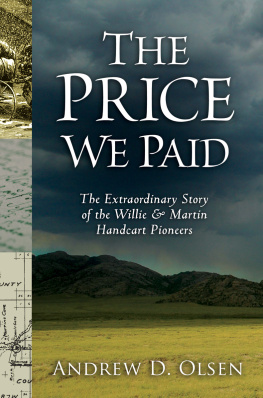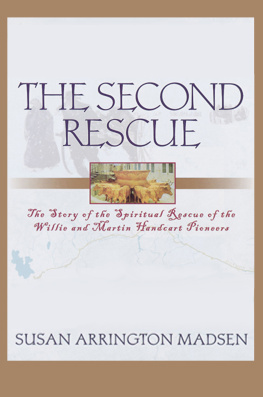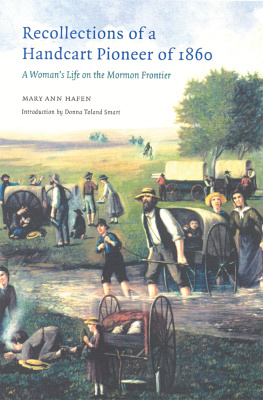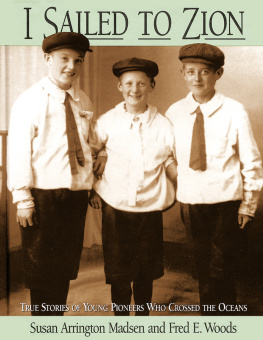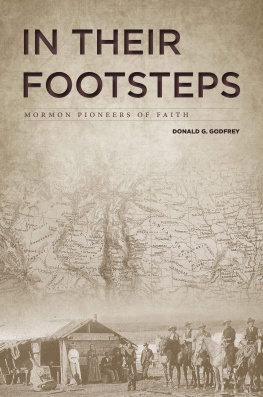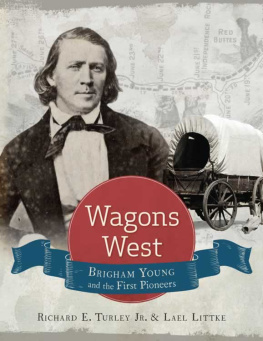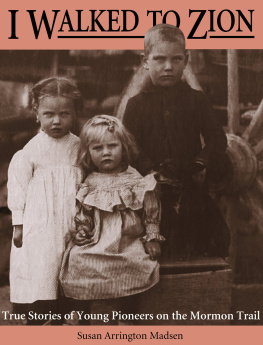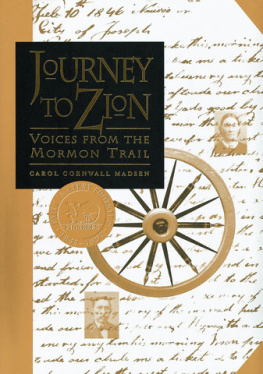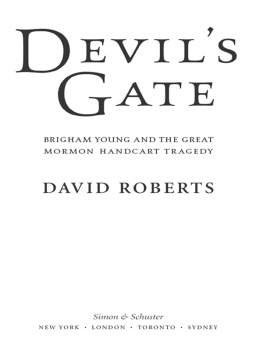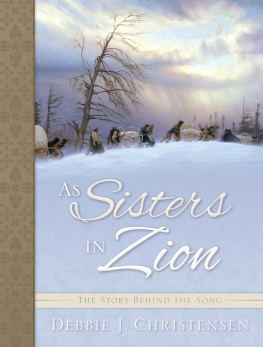Follow Me to Zion
Andrew D. Olsen, Jolene S. Allphin
2013 Andrew D. Olsen; Jolene S. Allphin.
All rights reserved. No part of this book may be reproduced in any form or by any means without permission in writing from the publisher, Deseret Book Company (permissions@deseretbook.com), P.O. Box 30178, Salt Lake City Utah 84130. This work is not an official publication of The Church of Jesus Christ of Latter-day Saints. The views expressed herein are the responsibility of the author and do not necessarily represent the position of the Church or of Deseret Book. Deseret Book is a registered trademark of Deseret Book Company.
Library of Congress Cataloging-in-Publication Data
Olsen, Andrew D., author.
Follow me to Zion : stories from the Willie handcart pioneers / Andrew D. Olsen and Jolene S. Allphin ; art by Julie Rogers.
pages cm
Includes bibliographical references and index.
ISBN 978-1-60907-594-1 (hardbound : alk. paper) 1. James G. Willie Emigrating Company. 2. Mormon pioneersWest (U.S.)Biography. 3. Mormon pioneersWest (U.S.)History. 4. Mormon handcart companies. 5. Mormon Pioneer National Historic Trail. 6. MormonsWest (U.S.)Biography. 7. Frontier and pioneer lifeWest (U.S.) 8. West (U.S.)History18481860. I. Allphin, Jolene, author. II. Rogers, Julieillustrator. III. Title.
F593.O47 2013
978'.02dc232013019437
Printed in the United States of America
Publishers Printing, Salt Lake City, UT
10 9 8 7 6 5 4 3 2 1
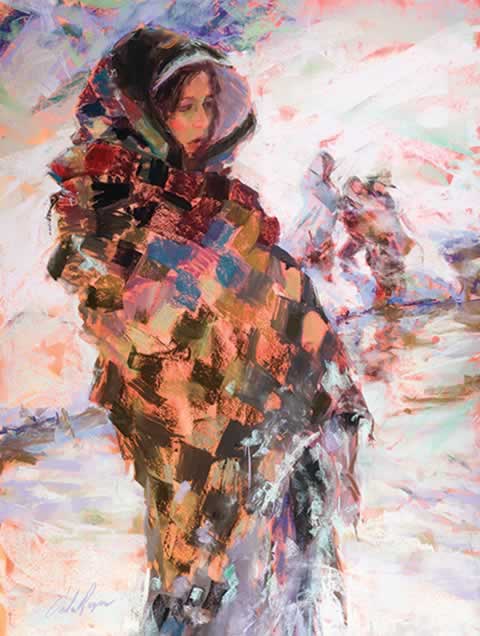
THE NORTH WIND
In crossing the Rocky Ridge, we had to encounter a heavy snowstorm, accompanied by a strong north wind.
-James G. Willie
Paintings

The North Wind Frontispiece
Chapter 1
Let Us Pray
Ministering
The Thornton
Heavily Laden
Friendly Guidepost
Reunion
Chapter 2
Songs to Encourage Us
Devoted Friends
Chapter 3
Gathered in His Arms
Mothers Back
We Knew Him
Chapter 4
Be Brave, My Boy
Day After Day
Family Love
Chapter 5
Work of Salvation
Herding
Chapter 6
Sisters in Zion
First Rescue
Chapter 7
Determination
Chapter 8
Mormon Boy
Chapter 9
The Gathering
Bodil
Chapter 10
Mother, Carry On
Keep Going
Chapter 11
Most Anxious
Chapter 12
Unsung
Mns Klint
Yoke on Her Shoulders
Chapter 13
The Steps We Have Taken
United
Sustenance
Chapter 14
I Asked Gods Help
Veil Crossing
Chapter 15
My Only Son Was among Them
Gather Round
Chapter 16
Reverence at Rock Creek
Looking Forward
Chapter 17
Sacred Sacrifice
Our Journey Home
The Light That Comprehendeth
Chapter 18
They Required My Assistance
Faithful Record
Crossing the Ridge
Hallowed Ground
Chapter 19
The Protecting Hand of the Lord
Christina
Ride to Zion
Chapter 20
The Rescuer
Bring Them In
The Blue Angel
Timely Arrival
Just in Time
Stationed at South Pass
Bringing Them Home
The Pioneer Trail
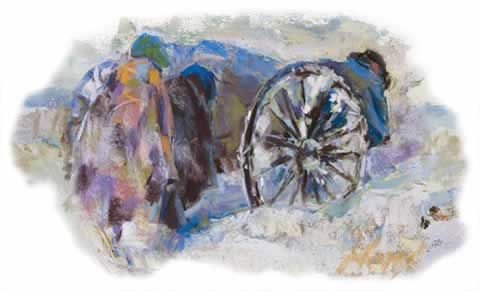
Preface

The fire of emigration blazes throughout the Pastorate, wrote William Kimball in 1855, while serving a mission to England for The Church of Jesus Christ of Latter-day Saints. Folks are willing to part with all their effects, and toddle off with a few things in a pocket-handkerchief, he continued. For years, Church leaders had been urging converts who lived abroad to gather to the Salt Lake Valley, where they could unite in building latter-day Zion. By 1855, thousands had already emigrated, but thousands more who yearned to gather with the main body of the Saints were too poor to afford the journey.
In the fall of 1855, President Brigham Young announced the handcart plan to help make emigrating more affordable. Instead of using wagons for the overland journey, these Saints would pull their belongings in handcarts for less than one-tenth of the cost. Millen Atwood, a missionary in England, said that when this plan was announced, it ran like fire in dry stubble, and the hearts of the poor Saints leapt with joy and gladness. He said they had prayed and fasted day after day, and night after night, that they might have the privilege of uniting with their brethren and sisters in [the] mountains.
The handcart plan was so popular that nearly 2,000 people signed up within the first few months, and by March 1856 they began sailing from Liverpool. Most of those who would become members of the Willie handcart company left Liverpool six weeks later, on May 4, 1856. After reaching America, the handcart Saints traveled to Iowa City, the western terminus of the railroad at the time, and from there they began the 1,300-mile trek to Zion.
Five handcart companies left Iowa City that year. The journey was arduous in the best of conditions, but the first three companies completed it more quickly and with no more deaths than a typical wagon company. The last two handcart companies of 1856the Willie and Martin companieshad a tragically different experience. Both ran short of provisions, and both were caught in winter storms while they were still hundreds of miles from Salt Lake City. Some 200 members of these companies died from illness, lack of nourishment, and exposure. While this tragedy should not be minimized, it is also a story of great triumph. The timely assistance of rescuers and the sacrifices the people made for each other helped save the lives of some 800 of these Saints.

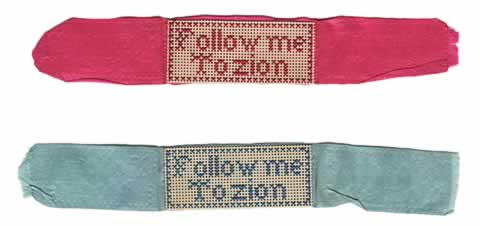
Tucked inside a journal belonging to handcart pioneer Thomas Normington are two fabric strips, each about six inches long and one inch wide, that were likely used as bookmarks. Attached to the center of each strip is a piece of cross-stitched fabric with the words Follow Me to Zion. These simple words are an invitation to devote ones life to God and his purposes. They are also an invitation for each person, whether in 1856 or today, to consider his or her path.
The Savior gave a similar invitation when he said, Come, follow me (Luke 18:22). He promised his richest blessings to those who accept this invitation, whatever sacrifices it may require: Every one that hath forsaken houses, or brethren, or sisters, or father, or mother, or wife, or children, or lands, for my names sake, shall receive an hundredfold, and shall inherit everlasting life (Matthew 19:29; see also Luke 18:2930).
Follow Me to Zion tells stories of members of the Willie handcart company who accepted those invitations with full devotion. In doing so, these Saints made tremendous sacrifices. Most of them left family, friends, property, and homelands so they could answer the call of a prophet to gather to Zion. After they reached the Salt Lake Valley, most of them continued to live by those invitations as they helped build Zion. Many of these Saints helped colonize multiple settlements, starting anew each time, sometimes in remote places where their first dwellings were dugouts.


